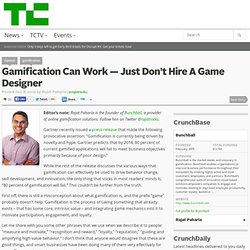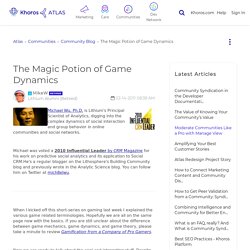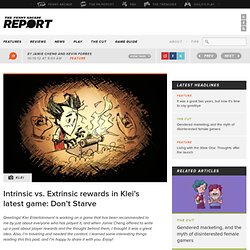

Real Gamification Mechanics Require Simplicity And, Yes, Game Designers Can Do It. Editor’s note: Tadhg Kelly is a game designer with 20 years experience.

He is the creator of leading game design blog What Games Are, and consults for many companies on game design and development. You can follow him on Twitter here. My gamification post two weeks ago (which described everything you really need to know) struck some nerves, especially as it came out just before a Gartner report claiming that 80 percent of gamified projects would fail. I received emails from several folks who had unsuccessfully tried to gamify their service and found the process frustrating, or felt that they had been sold some snake oil. Most commonly this was because they got caught up in the seductive fantasy of the engaged user who interacts on multiple levels rather than focusing on specific outcomes.
Gamification mechanics should be simple to understand. In principle this is straightforward. Fake Mechanics None of the above are game mechanics. Gamification Can Work — Just Don’t Hire A Game Designer. Editor’s note: Rajat Paharia is the founder of Bunchball, a provider of online gamification solutions.

Follow him on Twitter @rajatrocks. Gartner recently issued a press release that made the following provocative assertion: “Gamification is currently being driven by novelty and hype. Gartner predicts that by 2014, 80 percent of current gamified applications will fail to meet business objectives primarily because of poor design.” While the rest of the release discusses the various ways that gamification can effectively be used to drive behavior change, skill development, and innovation, the only thing that sticks in most readers’ minds is, “80 percent of gamification will fail.”
Gamification And UX: Where Users Win Or Lose. Advertisement The gaming industry is huge, and it can keep its audience consumed for hours, days and even weeks.

Some play the same game over and over again — and occasionally, they even get out their 15-year-old Nintendo 64 to play some Zelda. Now, I am not a game designer. I actually don’t even play games that often. I am, though, very interested in finding out why a game can keep people occupied for a long period of time, often without their even noticing that they’ve been sitting in front of the screen for hours. (Image credit: Axel Pfaender) Playful UX Design: Building A Better Game. Advertisement I sincerely believe that the user experience community should add game design to its toolbox of competencies.

If we’re truly committed to creating satisfying user experiences, then there’s no reason why games, which can satisfy people so richly, should be excluded. Operating successfully in the games domain means learning a new set of competencies, and I don’t want to oversimplify the challenges of designing high-quality game experiences. From Game Design Elements to Gamefulness. Games, Gamification, and the Quest for Learner Engagement. Game-based learning can turn disconnected, bored learners into engaged participants.

Juan sits in front of his laptop while slowly, painfully progressing through a customer service e-learning course. He is bored and disinterested. Juan wants desperately to click the "next" button in quick succession and rush through to the end. Then he can take the simplistic 10-question multiple-choice test, pass the course, and get back to work. Make the Job a Game - Robert H. Schaffer. By Robert H.

Schaffer | 9:00 AM September 10, 2012 “How can my people get so excited about guys hitting a ball with a wooden club and not care half as much about the phenomenal parts they are building for interplanetary rockets?” Meaningful Play - coding conduct. Meaningful Play Meaningful Play.

Getting »Gamification« Right. Presentation, Google Tech Talk, January 24, 2011, Mountain View, CA. Between promises of plain mind control and warnings of »pointsification«, the debate on »gamification« is deeply split. The Magic Potion of Game Dynamics. Michael Wu, Ph.D. is Lithium's Principal Scientist of Analytics, digging into the complex dynamics of social interaction and group behavior in online communities and social networks.

Michael was voted a 2010 Influential Leader by CRM Magazine for his work on predictive social analytics and its application to Social CRM.He's a regular blogger on the Lithosphere's Building Community blog and previously wrote in the Analytic Science blog. You can follow him on Twitter at mich8elwu. When I kicked off this short-series on gaming last week I explained the various game related terminologies. Hopefully we are all on the same page now with the basics. Now we are ready to talk about the cool and interesting stuff. The Fogg Behavior Model The goal of game dynamics is to drive a user-desired behavior predictably. Intrinsic vs. Extrinsic rewards in Klei’s latest game: Don’t Starve. Greetings!

Klei Entertainment is working on a game that has been recommended to me by just about everyone who has played it, and when Jamie Cheng offered to write up a post about player rewards and the thought behind them, I thought it was a great idea. Also, I’m traveling and needed the content. I learned some interesting things reading this this post, and I’m happy to share it with you. Enjoy! Back in 2010, Chris Hecker presented a talk about Intrinsic vs Extrinsic rewards, titled: Achievements Considered Harmful?
Karl Kapp.